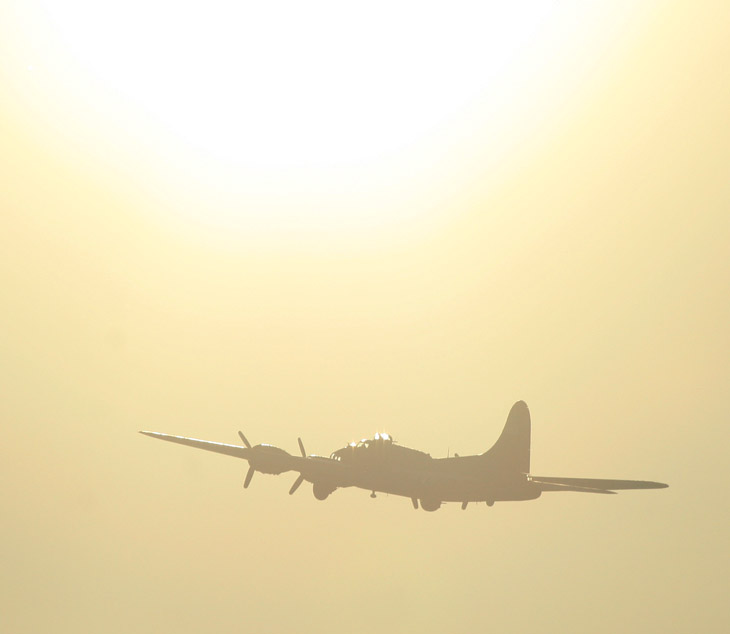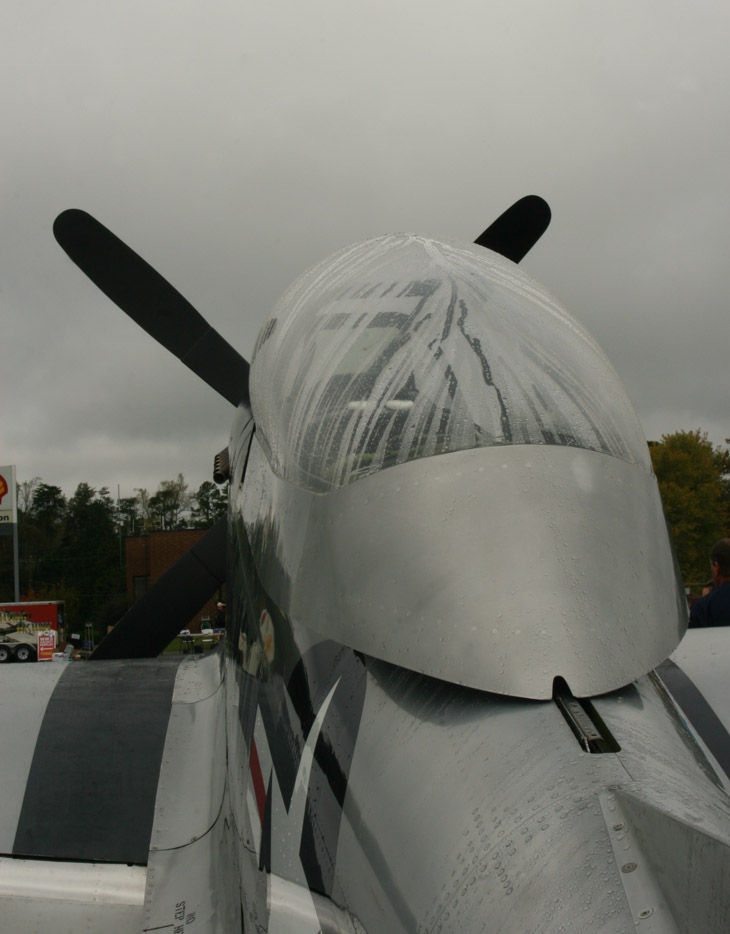
I told you I’d be back – I just didn’t say how freaking long it would take. Someday I will do a post about projects that took up way too much time, but that would be taking time away from the thing I’ve been trying to get to, which is this, so it’ll wait and take time away from something else.
Part 1 can be found here – for a brief recap, the Collings Foundation, a non-profit organization that restores and maintains vintage aircraft, had a Wings of Freedom Tour to bring three WWII era bombers and a fighter/trainer around the country, and I caught two of their stops, which was well worth the minimal admission fee, even when paid twice. As the image above implies, the second day that I visited came on the heels of a rainy afternoon and night, starting right about the time that they were supposed to be ferrying the planes from Raleigh-Durham to Burlington. In their day, the planes would fly in just about any kind of weather, but they’re older now and lack modern avionics, and so only fly in optimal conditions. This meant that the North American B-25 Mitchell “Tondelayo,” the medium bomber that I hadn’t gotten the chance to see at RDU, didn’t manage to leave there before the weather turned sour, and I was told that it was waiting for the clearing conditions of this day. The canopy seen here was of the North American TF-51D Mustang “Toulouse Nuts,” a trainer version of the P-51D that appeared late in WWII and did further duty in Korea.
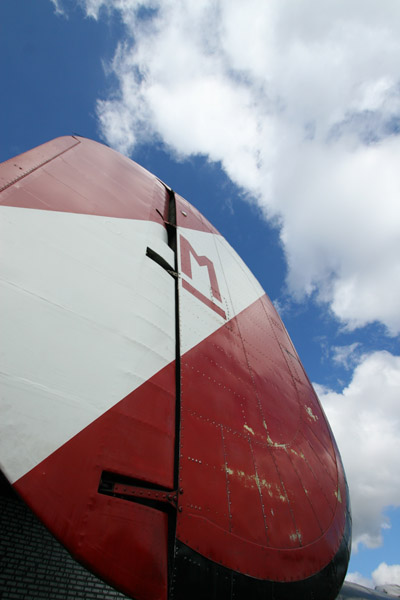 The day did indeed clear, so I have a nice mix of conditions from the Burlington session, but you’ll see shots from both – more fartsy stuff this time around, because I was experimenting a bit. This is the tail fin of the B-24J Liberator “Witchcraft,” which you’ve seen once or twice before (the plane itself, not necessarily the fin.) The interior layout is quite similar to the B-17G, and just as spacious.
The day did indeed clear, so I have a nice mix of conditions from the Burlington session, but you’ll see shots from both – more fartsy stuff this time around, because I was experimenting a bit. This is the tail fin of the B-24J Liberator “Witchcraft,” which you’ve seen once or twice before (the plane itself, not necessarily the fin.) The interior layout is quite similar to the B-17G, and just as spacious.
I admit to being guilty of bad planning for the second visit. While the day dawned cool and quite damp (keeping the crowds down,) I wanted to tour the B-25 that was promised to arrive, and was there for hours, many of them well after the sky cleared and the sun started beating down – and I hadn’t brought a hat or sunscreen. I ended up with a nice little sunburn, but small price, as far as I’m concerned. I got to chat with a lot of other fellow enthusiasts, including several veterans, and even offered a few shooting tips here and there. Fairly early on, the TF-51D was fired up to take some lucky people out for short airtours, and I literally had a front row seat – more on that anon.
As an enthusiast that has done quite a bit of reading about WWII aircraft, I ended up sharing a lot of that knowledge with more than a few people at both locations; I was a little surprised to be doing it for veterans of that very war, but those that I talked to hadn’t actually served in these aircraft (or indeed any, in most cases,) so I shouldn’t be surprised, I suppose – there’s no particular reason that they should be conversant with the aircraft, any more than pilots would know about the interior of Sherman tanks.
By the way, if your knowledge of bomber operations comes from the movie Memphis Belle, well, it could be better. It was overdramatized in places, and sanitized in others, at least according to most sources that I’ve found, and the real “Memphis Belle” had a relatively uneventful final mission. Just so you know.
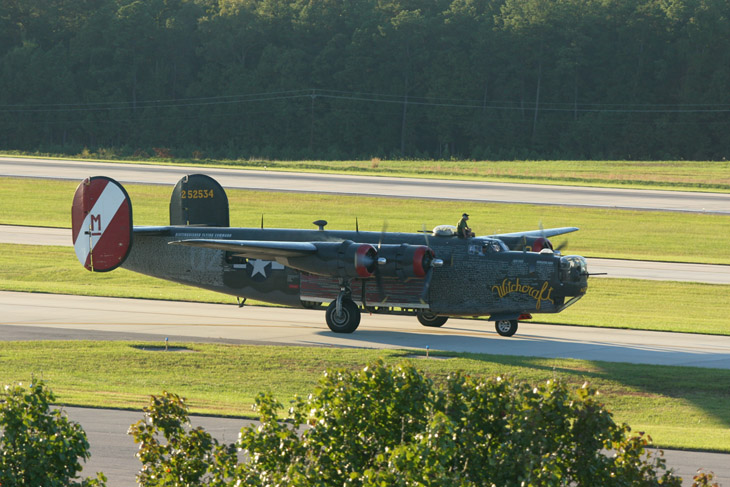
Here’s a look at the B-24J “Witchcraft” taxiing into RDU following an airtour; I can only guess at the purpose of the crewmember riding atop the cabin, and that guess is regarding visibility. But I also can’t see that the view from the cockpit would be any worse than for a commercial airliner, so it might also have to do with listening to the engines. Yes, they’re seventy-some years old and irreplaceable – in some cases, a failure would mean machining an entirely new part from scratch. I wish I could locate the article online, but many years back in Smithsonian Air & Space magazine, they talked about the difficulties in maintaining such aircraft in flying conditions – the search for parts or plans to machine them, the custom-made tires, and so on. It was not helped at all by the isolationist and competitive nature among some of the various organizations that were maintaining the aircraft, circumvented by a new cooperative approach, adopted by some, that allowed for pooled resources, trading, and a larger client-base when customized parts were required to be ordered.
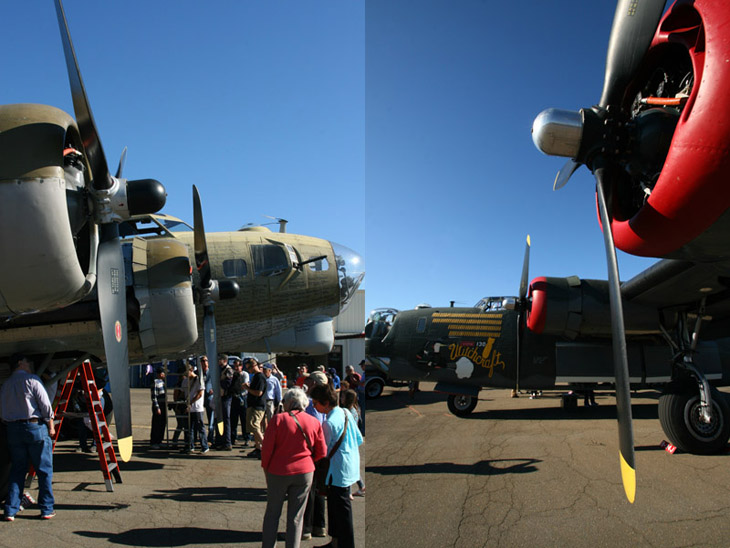
By the way, while much of the folklore emphasizes the B-17 (on the left) as the more capable and rugged heavy American bomber of the war, this article suggests that the B-24 (right) was actually a better aircraft overall; it certainly had a more modern look, and incorporated more advanced features. As is always the case within the military, those that operate the aircraft maintain that they fly the best planes available, yet only a handful of pilots have the opportunity to compare multiple models in similar conditions. Regardless, both models have extensive history behind them, with their own share of accomplishments.
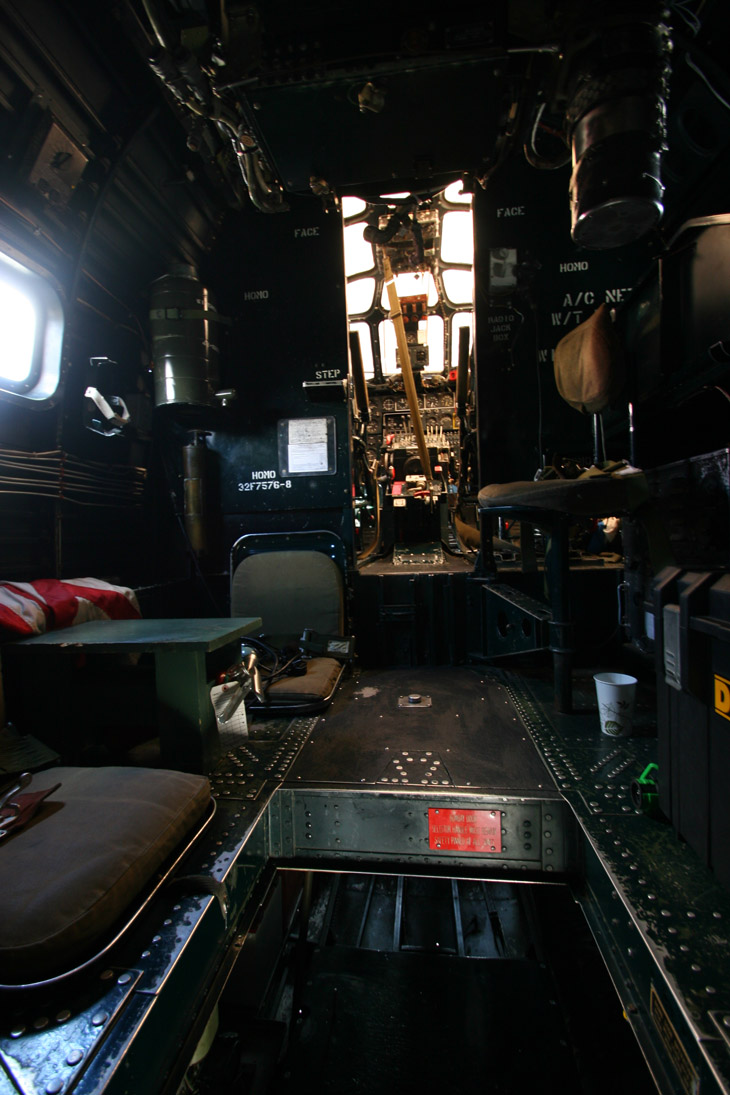
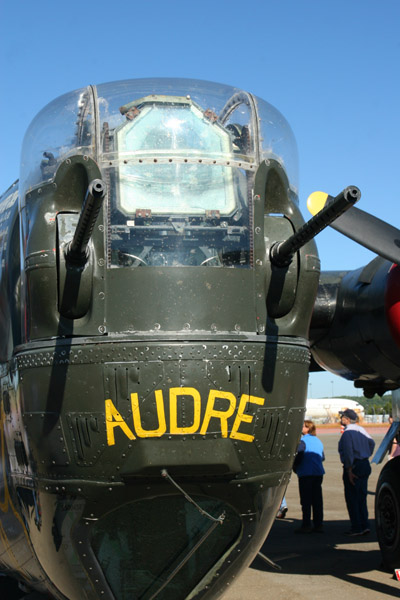 Above is a view of the interior of the B-24J, from the bomb bay looking forward; the bright area is the flight deck, while the immediate surroundings are the realm of the engineer (and top gunner) and radio operator. Further forward is the compartment that housed the navigator, bombardier, and nose-turret gunner – that hatch in the lower foreground allowed a tight access under the deck to the area, which sat below and in front of the flight deck. Using this access would have required one to crawl past the nose wheel, and I believe that the crew normally entered that section through the nose gear doors instead – still a tight squeeze. This area was closed off to visitors, so I simply poked the camera through the netting.
Above is a view of the interior of the B-24J, from the bomb bay looking forward; the bright area is the flight deck, while the immediate surroundings are the realm of the engineer (and top gunner) and radio operator. Further forward is the compartment that housed the navigator, bombardier, and nose-turret gunner – that hatch in the lower foreground allowed a tight access under the deck to the area, which sat below and in front of the flight deck. Using this access would have required one to crawl past the nose wheel, and I believe that the crew normally entered that section through the nose gear doors instead – still a tight squeeze. This area was closed off to visitors, so I simply poked the camera through the netting.
And of course an exterior view of the nose, with the nose-turret visible at top and the bombardier’s window at bottom. Unlike the B-17G, the nose gunner of the B-24J sat entirely within an enclosed booth, able to rotate with the turret itself. This arrangement was a development late in the history of the aircraft, since the original design was much simpler; radical difference between these two (and both shot at the same airport, though close to two decades apart.)
Another bit of trivia: unlike the B-17, the B-24 seen here did not have a forward hatch for crew access – the pilots, engineer, and radio operator all just used the bomb bay, which is how the people touring this aircraft exited, having gained entry through a crew hatch in the rear. Getting under the bomb bay doors required bending over double, since they cleared the ground by only a meter or so. I had thought the bay doors looked a little flimsy, and later found out that they were: they were designed so that not only could the bomb load drop through them without opening, in the event of a hydraulic failure for instance, so could the crewmembers! Which meant that anyone missing their footing while walking that tiny catwalk (shown in part 1) was taking a much bigger risk than initially imagined.
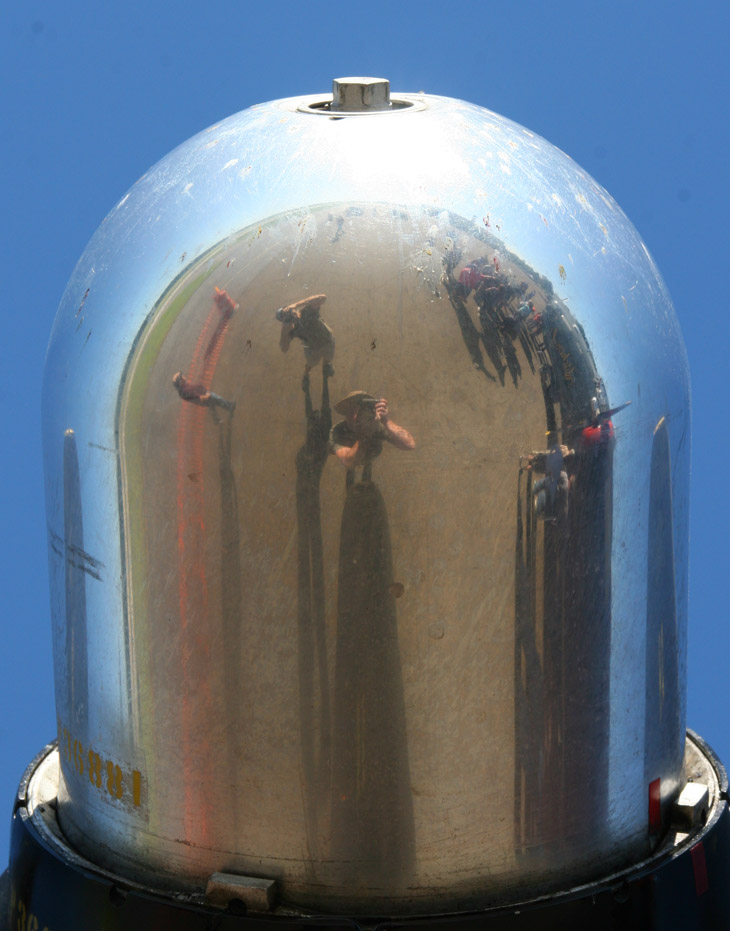
This seems as good a place as any for this one. Looking up at the gleaming spinner, the ‘nose cone’ of one of the propellers on the B-24J, I shot a couple of quick portraits of myself and the impertinent Mr Bugg, who quickly raised his own camera to semi-duplicate the shot (I had the better perspective.) You can see that one of us knows you only have to tilt the camera for a vertical composition, and not your entire head…
 A couple of very similar fartsy shots, as the weather at Burlington cleared up and became pleasant. The one to the left is the horizontal and vertical stabilizers (tail plane and rudder) of the B-17G “909” – it’s easy to see that the plane’s name came from the serial number, the other markings identify the bomber group and squadron, in this case the 91st Bomber Group (‘A’ in triangle) and 323rd Squadron (‘R’) within that group. High visibility markings permitted quick identification of aircraft for rendezvous, such as with fighter escorts or multiple squadrons meeting for the same mission. I incorrectly surmised in part 1 that the markings were fictional – I should have checked my pics of the placard that accompanied the plane, because it clearly says they’re based on a real aircraft that completed 140 missions without a loss of crewmember! This is, alas, not the same plane, which was eventually scrapped, but a stateside model later restored as a replica of a combat aircraft.
A couple of very similar fartsy shots, as the weather at Burlington cleared up and became pleasant. The one to the left is the horizontal and vertical stabilizers (tail plane and rudder) of the B-17G “909” – it’s easy to see that the plane’s name came from the serial number, the other markings identify the bomber group and squadron, in this case the 91st Bomber Group (‘A’ in triangle) and 323rd Squadron (‘R’) within that group. High visibility markings permitted quick identification of aircraft for rendezvous, such as with fighter escorts or multiple squadrons meeting for the same mission. I incorrectly surmised in part 1 that the markings were fictional – I should have checked my pics of the placard that accompanied the plane, because it clearly says they’re based on a real aircraft that completed 140 missions without a loss of crewmember! This is, alas, not the same plane, which was eventually scrapped, but a stateside model later restored as a replica of a combat aircraft.
Below is the TF-51D “Toulouse Nuts” getting prepped to go out on an airtour. While I would have been delighted to take one myself, the necessary two grand for a half-hour flight is income that hasn’t ever been so disposable, and it’s not likely to change anytime soon either, despite the obvious aesthetic and artistic skills so plainly evident here, just waiting to be discovered. However, if the Foundation is interested in having such a thing documented in detail and will provide the ride gratis, I am easy to reach…
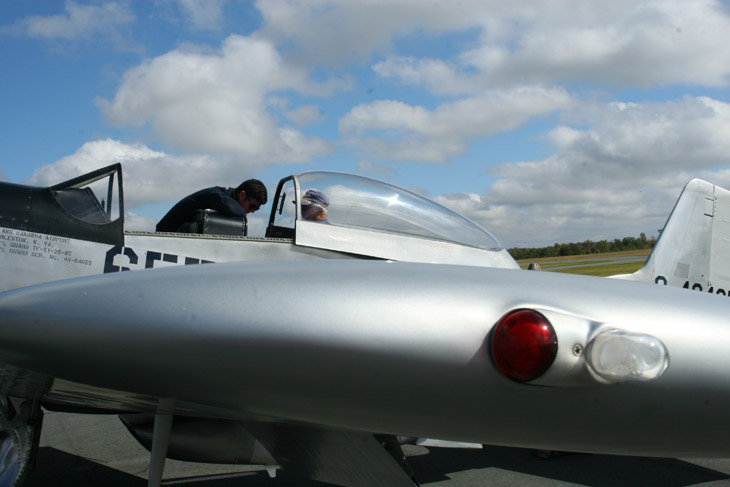
I’ve said this before, and will likely keep disclaiming it until I feel less ashamed of my skills, but I’m not an accomplished videographer. This wasn’t enough to prevent me from shooting some video while I was there, and I combined two clips into a short illustration while the TF-51D started up, taxied out, and took off. The production of this, as simple as it seems, was the thing that prompted the remarks about projects that opened this post; this took a whole lot longer than it should’ve, mostly with software that wasn’t performing as advertised. This isn’t exactly what I was aiming for, but it’s close enough to pass muster – for me, anyway.
That wasn’t too painful, was it? Things will improve eventually.
Somewhere around the second tour of the TF-51D, we spotted the arrival of the B-25 Mitchell “Tondelayo,” finally making it over from RDU now that the weather was amenable. And full credit to the pilot, who could easily have approached and landed without anyone noticing at all, but he instead made a pass right along the flight line, even doing a nice bank to present the plane in direct profile as it passed almost overhead. Thankfully I was already prepared with the 100-300 L affixed, and could do a few nice shots during the pass.
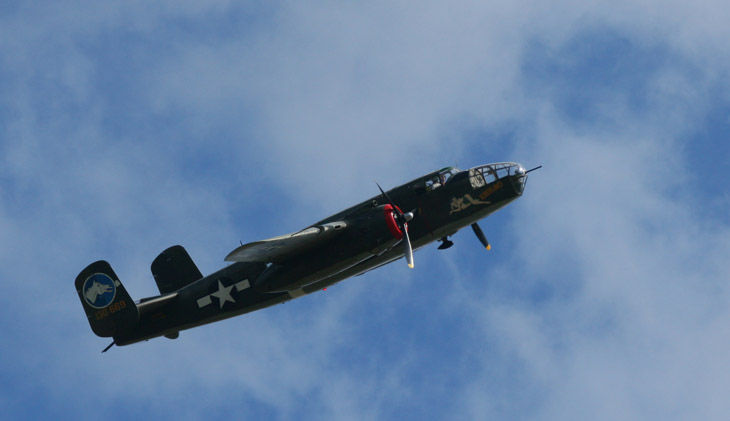
Since this was my second visit, I was determined to see all of the aircraft inside and out, and had been waiting for this plane to arrive. However, when it taxied up it parked well out on an apron outside of our access, most likely because it was now getting later in the day and they had already booked people to take an airtour on it, so there wasn’t time to put it on static display. I realized that, on the odd chance that it did open up for viewing, it wouldn’t be for at least another hour and I was already noticing how much sun I’d gotten, so I decided to wrap my visit up then – I’d been there for close to four and a half hours, so that was probably enough.
One small note, as I close with an image of “909” heading out at sunset from RDU: as I was driving away and passing directly under the approach path for the airport, “Heavy Metal (Takin’ a Ride)” by Don Felder began playing on the car stereo. Not the most remarkable of occurrences, seeing as how the stereo was playing my own MP3s, but it was set on random. If you can figure out the significance of this, more power to you.
